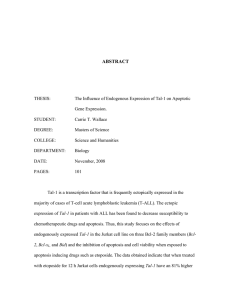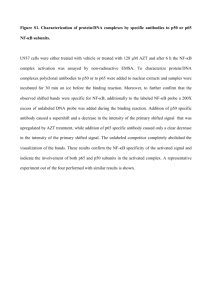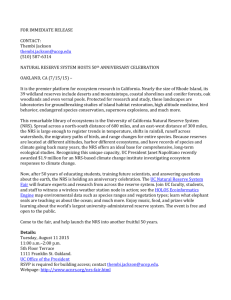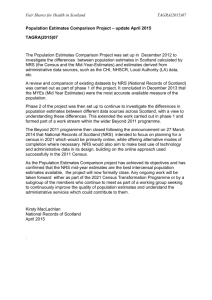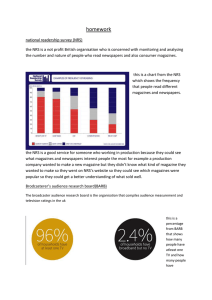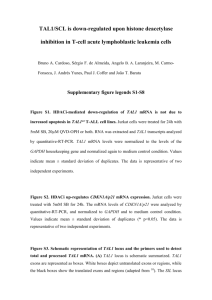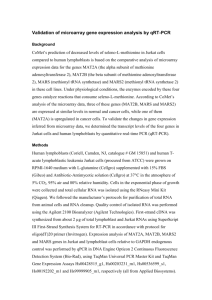κB THE ROLE OF TAL1 AND THE ATYPICAL NF-
advertisement
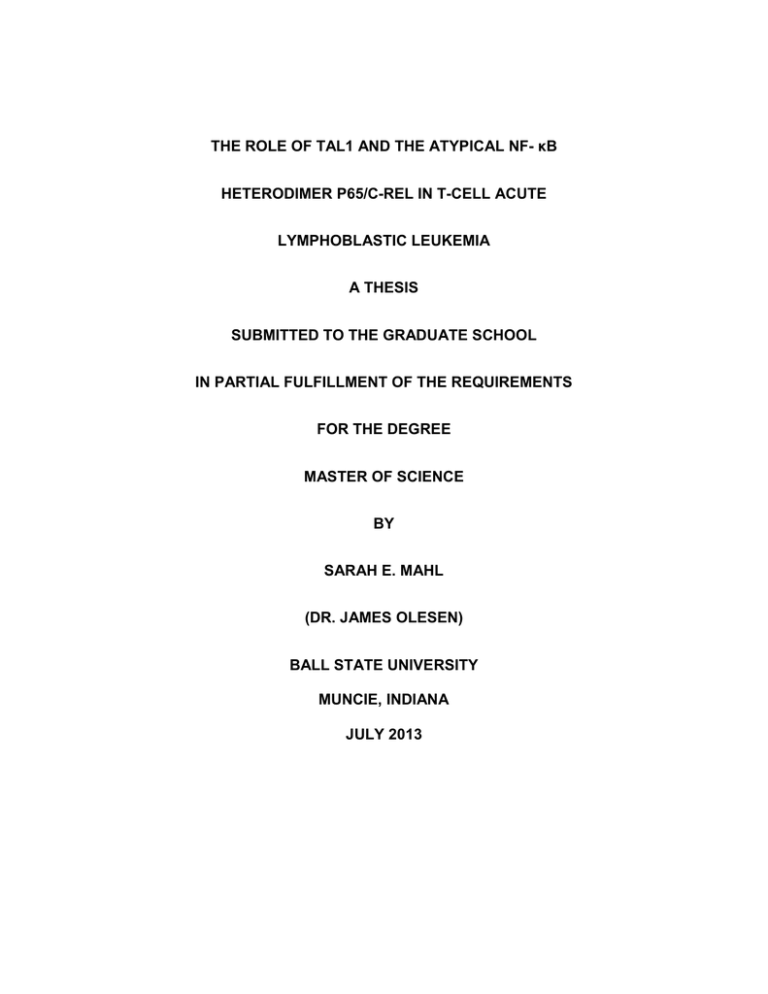
THE ROLE OF TAL1 AND THE ATYPICAL NF- κB HETERODIMER P65/C-REL IN T-CELL ACUTE LYMPHOBLASTIC LEUKEMIA A THESIS SUBMITTED TO THE GRADUATE SCHOOL IN PARTIAL FULFILLMENT OF THE REQUIREMENTS FOR THE DEGREE MASTER OF SCIENCE BY SARAH E. MAHL (DR. JAMES OLESEN) BALL STATE UNIVERSITY MUNCIE, INDIANA JULY 2013 INTRODUCTION The TAL1/SCL gene encodes a basic helix-loop-helix transcription factor that can form heterodimers with ubiquitously expressed E-proteins (E12, E47, HEB, and E2-2), as well as, other transcription factors (GATA1/2, Ldb1, and LMO2) [1-5]. These heterodimers translocate to the nucleus and bind to E-box/GATA sites to both activate and repress transcription of numerous target genes [6]. TAL1 normally functions as a hematopoietic regulator promoting erythroid differentiation [5]. In 60% of T-ALL 1 patients, TAL1 has been found to be up-regulated [7-9]. Overexpression is due to a translocation event (t1;14), which places the TAL1 gene under the control of the active TCRα 2 locus [2, 10]. Ectopically expressed TAL1 is thought to stimulate cellular proliferation and has been shown to delay apoptosis by activating and repressing genes involved in cell proliferation, erythroid differentiation, cell cycle control, and apoptotic resistance [2, 7, 8, 11]. For example, in some leukemic cell lines, TAL1 has been found to down-regulate expression of NFκB1, leading to the loss of p50 and the formation of the atypical p65/c-Rel NF-κB heterodimer [5, 12]. This, in turn, has been shown to promote an anti-apoptotic response. The NF-κB family of transcription factors is involved in cell cycle control, inflammatory response, cellular development, and apoptosis [13, 14]. The five members of the NF-κB family include NF-κB1 (p50/p105), c-Rel, RelA (p65), RelB, and NF-κB2 (p52/p100). NF-κB proteins form homo- and heterodimers to facilitate transcription of numerous target genes. In order to regulate the activity of the NF-κB 1 2 T-cell acute lymphoblastic leukemia T-cell receptor α 2 dimers, IκB 3 proteins, including IκB-α, IκB-β, and IκB-ε, bind and prevent nuclear translocation. IκB-α is the primary regulator of the classic NF- κB heterodimer (p50/p65), while IκB-ε has been implicated as the primary regulator of the p65/c-Rel complex. Additionally, the activity of IκB proteins is regulated through phosphorylation by the IKK 4 complex, which is composed of IKKα, IKKβ, and IKKγ (NEMO) [14]. Phosphorylated IκB proteins are polyubiquitinated and targeted for proteosomal degradation. In the canonical pathway leading to NF-κB activation, TNFα first binds to TNFR1 5 allowing it to recruit TRAF2 6 and RIP1 7, thus forming a protein complex [15]. The E3 ubiquitin ligase, cIAP-1 8, then ubiquitinates RIP1, allowing RIP1 to recruit and phosphorylate IKK via MEKK3 9 or TAK1 10. Once phosphorylated, the IKKβ subunit of the IKK complex phosphorylates IκB proteins at serine residues, leading to the polyubiquitination and degradation of the IκB proteins. This allows NF-κB protein dimers to translocate to the nucleus. The non-canonical NF-κB activation pathway is initiated by the phosphorylation of IKKα by NIK 11 [14]. Activated IKKα then phosphorylates p100, which is polyubiquitinated and processed by the proteasome to p52. P52 then binds to RelB and this heterodimer translocates to the nucleus. Both of these pathways induce the formation of dimers that allow NF-κB members to dimerize Inhibitor of κB IκB Kinase 5 TNF receptor 1 6 TNF receptor-associated factor 2 7 Receptor-interacting protein kinase 1 8 Cellular inhibitor of apoptosis protein-1 9 MAPK kinase kinase 3 10 TGF-β-activated kinase 1 11 NF-κB-inducing kinase 3 4 3 and act as transcriptional activators (p50/p65, p65/p65, p50/c-Rel, and p65/c-Rel) or transcriptional repressors (p50/p50 and p52/p52) [14, 16, 17]. In regards to apoptosis, NF-κB complexes have been found to regulate the transcription of pro-apoptotic (Fas, FasL, and c-myc) and anti-apoptotic (cIAP-1/2, TRAF1/2, XIAP, MnSOD, Bcl-XL, and IEX-1L) genes [13, 15, 18]. Recent research has determined that most NF-κB family members (p50, p65, c-Rel, p52) promote cell survival in blood cell lineages, including B-cells, T-cells, DC 12, APC13, and macrophages [16]. Additionally, mouse NF-κB knockout models exhibit embryonic lethality due to an inability to resist TNFα-induced apoptosis. It is thought that NF-κB activation by TNFα signaling promotes transcription of IAPs14 [14], which inhibit caspase activity and halt apoptotic signaling [13, 15, 18]. NF-κB proteins have also been shown to promote the transcription of TRAF proteins, which form complexes at TNF receptors and activate NF-κB signaling [13, 15, 19]. Therefore, NF-κB proteins promote their own expression through the up-regulation of the IAPs and TRAFs and stimulate an antiapoptotic positive feedback loop. Overall, the transcriptional targets of NF-κB are not fully characterized and its role in apoptosis is unclear. Of interest to this study are the recent reports that show TAL1 binds to the E-box in the promoter of the NF-κB1 gene, thus repressing transcription and translation of p50 in some T-cell lines [5, 12]. With loss of p50, the formation of an atypical heterodimer, p65/c-Rel, was promoted. This complex has been found to be neuroprotective, may promote proliferation and can elicit anti-apoptotic responses in many different cell types 12 dendritic cells antigen presenting cells 14 Inhibitor of apoptosis proteins 13 4 including liver cells, macrophages, and T-cells [16, 18, 20]. The results from this study indicate that when Jurkat cells are treated with TNFα, there is a subsequent upregulation of various proteins including p65, c-Rel, IKKγ/NEMO, and TAL1 in comparison to etoposide-treated cells. This potentially suggests that TAL1 expression may be influenced by the TNFR1 pathway, thus helping to clarify the role of TAL1 in promoting cell survival in malignant T-cells. EXPERIMENTAL PROCEDURES Cell Culture and Drug Treatments – Jurkat cells were cultured in RPMI 1640 supplemented with 10% BGS (Thermo Scientific) at 37°C and 5% CO2. Cells were treated for 24 hr with etoposide (1 µM and 5 µM; Enzo), TNFα (250 ng/ml and 500 ng/ml; Peprotech), or a combination of both (1 µM etoposide/250 ng/ml TNFα or 5 µM etoposide/500 ng/ml TNFα). Cell counts were completed by trypan blue exclusion. One hundred microliters of cell suspension was resuspended with 50 μl of trypan blue and visualized on a hemacytometer. The percent cell death in a population was determined as the difference between the number of cells in the control and the treatment group divided by the number of cells in the control then multiplied by 100. Protein Extraction and Determination – Cells were centrifuged at 1000 rpm for 5 min at 4°C and washed with 1X PBS containing Ca2+ and Mg2+. Cytoplasmic protein fractions were prepared by homogenizing the cells with a Dounce homogenizer in Dignam’s Buffer A [10 mM Hepes (pH 7.8), 1.5 mM MgCl2, 10 mM KCl, 0.2 mM EDTA, 5 0.2 mM EGTA] containing HALT protease inhibitors (Thermo Scientific). The released nuclei were separated from the cytoplasmic protein fraction by centrifugation at 10,000 rpm for 15 min at 4°C. The supernatant containing the cytoplasmic protein fraction was aliquoted into microfuge tubes and stored at -80°C. Then, Dignam’s Buffer B [20 mM Hepes (pH 7.8), 1.5 mM MgCl2, 420 mM KCl, 25% Glycerol, 0.2 mM EDTA, 0.2 mM EGTA], containing HALT protease inhibitors, was added to the nuclear pellet. Nuclei were resuspended and rocked at 4°C on a platform shaker for 30 min. The suspension was centrifuged at 13,000 rpm for 10 min at 4°C and the supernatant containing the nuclear protein fraction was aliquoted into microfuge tubes and stored at -80°C. Cytoplasmic and nuclear protein concentrations were determined via a modified Bradford assay using Protein Assay Dye Reagent Concentrate (Bio-Rad) and Protein Assay Standard II (Bovine Serum Albumin; Bio-Rad) according to the manufacturer’s instructions. Western Blot Analysis – Twenty micrograms of each protein sample was incubated with 4X Protein Loading Buffer (LI-COR) prior to gel loading. Proteins were separated on a 10% polyacrylamide gel at 100V for 1 ½ - 2 hr and then transferred to Protran nitrocellulose membrane using a semi-dry apparatus (Owl Scientific). Blots were rinsed in PBS and blocked in LI-COR Odyssey blocking buffer for 1 hr prior to an overnight incubation with antibodies against p50 (Santa Cruz Biotechnology), p65, cRel, IKKγ/NEMO, NIK, IκBα, cleaved caspase-8, β-tubulin, cIAP1 (Cell Signaling Technology), and TAL1 (OriGene). Next, blots were rinsed in PBS/0.1% Tween-20 and incubated with the appropriate IRDye 688 secondary goat anti-rabbit or goat anti-mouse antibody (LI-COR) for 1 hr. A final wash in PBS/0.1% Tween-20 and PBS was 6 completed prior to imaging. The LI-COR Odyssey Infrared Imaging system (Model 9120) was used to collect and process images of each blot. The relative band intensity of each protein was determined via densitometry analysis and normalized against the loading control (β-tubulin). Following densitometric analysis, Western blots were stripped and re-probed with additional antibodies using the Odyssey Newblot Nitro Stripping Buffer according to the manufacturer’s instructions. Flow Cytometry/Immunostaining – Approximately 1 X 106 Jurkat cells were resuspended in FACS & FIX buffer (0.75% formaldehyde, 2% BSA in 1X PBS) and incubated for 5 min. Next, permeabilization buffer (1X PBS/0.005% Tween-20) was added and left to incubate for 15 min. Permeabilized cells were then incubated with the appropriate primary antibody (same as used for Western blotting) for 15 min in the dark, resuspended in additional permeabilization buffer, and centrifuged at 4°C. The supernatant was discarded and cells were then stained with an Alexa Fluor 488 secondary antibody (Cell Signaling Technology) for 10 min in the dark, centrifuged again at 4°C, and the supernatant was removed. Cell pellets were resuspended in FACS buffer (2% BSA/1X PBS) and kept on ice prior to analysis with a Becton Dickinson-Accuri C6 Flow Cytometer. Cells were gated to a background control population stained with only an Alexa Fluor 488 secondary antibody. Mean fluorescence values above background were determined for 100,000 events for each sample. Histogram plots of protein expression levels in each treatment group were generated (SigmaPlot; Systat Software, Inc.). 7 Caspase-8 Activity Assay – Caspase-8 activity in each protein sample was assessed in the following manner. Drug-treated Jurkat cells were resuspended in cell lysis buffer (Promega), subjected to two freeze-thaw cycles and then incubated on ice for 30 min. The cellular suspension was centrifuged at 13,000 rpm for 15 min at 4°C to pellet cellular debris, after which, the supernatant was aliquoted into microfuge tubes for analysis. The protein concentration of each sample was determined as described previously. To individual wells on a 96-well plate, caspase reaction buffer [25 mM Hepes (pH 7.4), 100 mM NaCl, 5 mM DTT, 1 mM EDTA, 0.1% CHAPS], caspase-8 substrate (AC-IETD-pNA; Enzo), and 100 μg of protein was added. Additionally, a caspase-8 inhibitor (AC-IETD-CHO; Enzo) was added to specific wells as a control. The plate was incubated at 37°C in a Tecan Infinite M200 microplate reader set to 405 nm. Absorbance was measured every 30 min over a 4 hr period by the Tecan I-Control software. Relative absorbance values were calculated by determining the difference between the absorbance of uninhibited and inhibited samples normalized against the control at 2 hr to determine the level of caspase-8 activity. Statistical Analyses – Flow cytometry and caspase activity assay experiments, comparing three or more groups, were analyzed using one-way ANOVA with a StudentNewman-Keuls post-hoc analysis (SigmaPlot). 8 RESULTS Assessment of Cell Proliferation/Death Cell count/cell death assays were performed at various concentrations of TNFα and etoposide to assess cell viability (Fig. 1). Cell death upon TNFα treatment increased from 6.0% (50 ng/ml) to 27.2% (500 ng/ml) whereas, cell death increased from 55.7% (1 μM) to 89.0% (10 μM) with etoposide treatment. At the highest concentrations of drug used, TNFα treatment resulted in less than 30% death, while etoposide treatment led to almost 90% cell death. Overall, treatment with TNFα induced less cell death than treatment with etoposide. a) b) Fig. 1 - Cell count/cell death as determined by trypan blue exclusion. Jurkat cells were plated in 1 ml RPMI 1640 + 10% BGS on a 6-well plate and drug-treated for 24 hr with TNFα (a) or etoposide (b) at concentrations indicated. A cell count was then made on each well and percent cell death was determined. 9 Assessment of Protein Expression by Western Blot Western blotting was performed to determine the expression levels of p50, p65, c-Rel, NIK, IKKγ/NEMO, IκBα, caspase-8, cleaved caspase-8, cIAP1, TAL1, and βtubulin in both cytoplasmic and nuclear extracts (Fig. 2). Densitometric analysis was completed on individual Western blots and the band intensity for each protein was normalized to β-tubulin expression (Table 1). a) b) Fig. 2 – Cytoplasmic and nuclear protein expression in drug-treated Jurkat cells. Jurkat cells were treated for 24 hr with etoposide (1 μM or 5 μM), TNFα (250 ng/ml or 500 ng/ml), or a combination of both (1 μM etoposide/250 ng/ml TNFα or 5 μM etoposide/500 ng/ml TNFα). Cytoplasmic (a) and nuclear (b) proteins were extracted as described previously. Western blot analysis of p50, p65, c-Rel, NIK, IKKγ/NEMO, IκBα, cIAP1, TAL1, caspase-8 (C8), cleaved caspase-8 (CC8), and β-tubulin was performed. 10 Cytoplasmic Extracts a) Treatment Group 1uM Et 5uM Et 250 TNF 500 TNF 1/250 5/500 p105 22% -43% -9% 12% 2% -42% p50 -7% -5% -11% 47% 54% 10% p65 -4% 20% -16% 22% 51% -13% % Difference from Control CC8 18 C8 57 c-Rel 45% 24% 502% -37% -23% 1262% 15% 368% 3% 23% 140% 45% 1% 26% 1076% -20% 2898% -2% p65 -19% 14% 20% 15% 8% -18% % Difference from Control c-Rel CC8 18 C8 57 -47% 36% -37% 37% 226% -28% -8% 132% 79% -45% 137% -15% -51% 30% -46% -48% 392% -53% C8 10 116% 97% 103% 89% 100% 213% NIK 28% -72% -67% -84% -24% -95% IKKg 69% -28% 88% 56% 80% 48% IkBa 108% 35% 182% 371% 347% 337% cIAP1 17% -56% 15% -12% -26% -32% C8 10 49% 146% 169% 150% 34% 225% NIK 530% 2245% 1133% 1481% 96% 2434% IKKg -12% 53% 235% 132% 32% 119% cIAP1 -23% 58% 127% 3% -40% -23% TAL1 11% 30% 169% 84% -31% 189% Nuclear Extracts b) Treatment Group 1uM Et 5uM Et 250 TNF 500 TNF 1/250 5/500 p105 15% -17% 33% 17% 15% 48% p50 -26% -7% 40% 16% 6% -4% Table 1 – Densitometry analysis of cytoplasmic and nuclear protein expression in drugtreated Jurkat cells. The relative band intensity of each protein in Fig. 2 was determined from densitometry analysis and normalized to the expression of β-tubulin. Cytoplasmic (a) and nuclear (b) protein expression was quantified and expression levels above control were determined. Green boxes indicate positive protein expression levels relative to control while red boxes indicate negative protein expression levels relative to control. From Fig. 2a and Table 1a, cytoplasmic expression levels of the NF-κB family members p105, p50, p65, and c-Rel did not vary much from control across all treatments. Only slight increases or decreases in expression were detected for these proteins. Additionally, expression of cIAP1 and the p57 subunit of caspase-8 followed a similar variable pattern. In contrast, NIK expression was generally reduced in all drugtreated samples. From Table 1a, NIK expression in the 1μM etoposide-treated sample was only slightly elevated above control (28%) whereas, all other samples exhibited a general decrease in expression ranging from 24-95%. Conversely, expression of IKKγ/NEMO was only decreased in the 5 μM etoposide-treated sample (28%) while expression was greater in all other treated samples (48-88%). Expression levels of 11 IκBα, the p10 subunit of caspase-8, and the p18 subunit of cleaved caspase-8 were elevated in all treated samples as compared to control levels (Fig. 2a, Table 1a). In the case of IκBα, expression was elevated between 35-371%. Similarly, caspase-8 p10 subunit expression ranged from 89-213% (Table 1a). For the p18 subunit, expression ranged from 140-2898% (Table 1a). Nuclear expression levels of p105, p50, and p65 did not vary much from control across all treatments (Fig. 2b, Table 1b). The expression of these proteins exhibited only slight increases or decreases from control expression as determined by densitometric analysis (Table 1b). Conversely, c-Rel expression decreased in most treated samples, ranging from 8-51%. Increased c-Rel expression was only detected in the 5 μM etoposide-treated sample (37%). Additionally, expression of cIAP1 was variable, ranging from 40% below to 127% above control expression. Expression of the p57 subunit of caspase-8 was generally lower in all drug-treated samples (Table 1b). The p57 subunit of caspase-8 was only increased in the 250 ng/ml TNFα-treated sample (79%), while all other treated samples exhibited a decrease in expression ranging from 15-53%. Furthermore, NIK expression was highly elevated and ranged from 96-2434% (Table 1b). IKKγ/NEMO expression was also elevated in most drugtreated samples. IKKγ/NEMO was slightly lower in the 1 μM etoposide-treated sample (12%), but exhibited an increase in expression ranging from 32-235% in other treated samples. In Fig. 2b and Table 1b, nuclear expression levels of the p10 subunit of caspase-8 and the p18 subunit of cleaved caspase-8 were elevated in all treated samples as compared to control levels. The p10 and p18 subunits were not as highly expressed, but still exhibited increased expression levels across all treatments. Nuclear 12 expression of the p10 subunit mirrored its cytoplasmic expression, ranging from 34225%, while expression of the p18 subunit ranged from 30-392% (Table 1b). Finally, TAL1 expression was lower in the 1 μM etoposide/250 ng/ml TNFα-treated sample whereas, all other samples exhibited a general increase in expression ranging from 11189% (Table 1b). Assessment of Protein Expression by Flow Cytometry In Fig. 3, the expression levels of various proteins were determined following intracellular staining. Expression comparisons were then statistically analyzed between all treatment samples. In Fig. 3a, TAL1 expression was found to be significantly different between both single TNFα treatments and the 1 μM etoposide treatment when compared to the 5 μM etoposide treatment. Also, TAL1 expression in the 1 μM etoposide sample was significantly different from the 5 μM etoposide/500 ng/ml TNFα treatment, but was not different from the single TNFα treatments. Furthermore, TAL1 expression in the 5 μM etoposide sample was not statistically different from the dual treatment samples. No significant differences in TAL1 expression were detected between the dual treatments or between the single TNFα treatments. 13 a) b) c) d) e) Fig. 3 – Intracellular staining levels of various proteins in drug-treated Jurkat cells. Jurkat cells were treated for 24 hr with etoposide (1 μM or 5 μM), TNFα (250 ng/ml or 500 ng/ml), or a combination of both (1 μM etoposide/250 ng/ml TNFα or 5 μM etoposide/500 ng/ml TNFα). Using flow cytometry, the mean fluorescence (MF) values for TAL1, p65, c-Rel, IKKγ, and cleaved caspase-8 expression were determined and normalized against cells stained with secondary antibody alone. Replicate experiments were analyzed by one way ANOVA with Student-Newman-Keuls post hoc analysis. Statistically significant differences (p < 0.05) in protein expression between treatment groups are indicated by asterisks (*). 14 Expression of p65 was found to be statistically different in the 250 ng/ml TNFα sample when compared to all etoposide-treated samples (Fig. 3b). Expression of p65 was also significantly different in the 500 ng/ml TNFα-treated sample as compared to the 5 μM etoposide/500 ng/ml TNFα-treated samples and both individual etoposidetreated samples (Fig. 3c). However, c-Rel expression in the 500 ng/ml TNF α sample was not found to be significantly different from the 1 μM etoposide/250 ng/ml TNFαtreated sample. Additionally, no significant differences in protein expression were detected between the 250 and 500 ng/ml TNFα-treated samples, the 1 μ and 5μM etoposide-treated samples, or the dual-treated samples. In Fig. 3d, IKKγ/NEMO expression was found to be significantly different in most etoposide-treated samples (either single or dual) relative to single TNFα-treated samples. For example, the 250 ng/ml TNFα-treated sample was statistically different from all treated samples except for the 500 ng/ml TNFα-treated sample. Furthermore, IKKγ/NEMO expression was significantly different in the 500 ng/ml TNFα-treated sample when compared to both 5 μM etoposide-treated samples (single and dual) and the 1 μM etoposide/250 ng/ml TNFα-treated sample. Finally, no difference was found between the single etoposide-treated samples, the single TNFα-treated samples, or the dual-treated samples. In Fig. 3e, cleaved caspase-8 expression was only found to be statistically different in the 5 μM etoposide/500 ng/ml TNFα-treated sample as compared to the 500 ng/ml TNFα-treated sample. No statistically significant difference in cleaved caspase-8 expression was detected among any other treated samples. 15 Assessment of Caspase-8 Activity Caspase-8 activity was assessed in drug-treated Jurkat whole cell extracts (Fig. 4). The activity of cleaved caspase-8 in each sample was determined by measuring the amount of pNA 15 released from the caspase-8 pseudosubstrate, AC-IETD-pNA. When the absorbance of each treated sample was subtracted from the untreated control and the values were statistically analyzed, no significant differences were detected (Fig. 4). Overall, caspase-8 activity was not significantly different (p > 0.05) between any treatment group regardless of the drug or concentration used. Fig. 4 - Caspase-8 activity in drug-treated Jurkat cell extracts. Jurkat cells were treated for 24 hr with etoposide (1 µM or 5 µM), TNFα (250 ng/ml or 500 ng/ml) or a combination of both (1 µM etoposide/250 ng/ml TNFα or 5 µM etoposide/500 ng/ml TNFα). Whole cell extracts from each sample were loaded into duplicate wells on a 96-well plate along with caspase reaction buffer and caspase-8 substrate. Caspase-8 inhibitor was added to a second set of duplicate wells as a control. Caspase-8 activity was calculated as the change in relative absorbance as determined by the difference between the absorbance of uninhibited and inhibited samples normalized against the untreated control at 2 hr. The mean absorbance from replicate experiments was plotted and assessed by one way ANOVA. 15 p-nitroaniline 16 DISCUSSION The up-regulation of TAL1 with TNFα treatment, as compared to etoposide treatment, indicates that TAL1 may regulate the expression of other genes/proteins that are part of the TNFR pathway. However, the mechanism by which TAL1 coordinates an anti-apoptotic response is poorly characterized. It is known that TAL1 is up-regulated in many leukemic T-cell lines, including Jurkat cells, and that TAL1 is overexpressed in many T-ALL patients due to a translocation event (t1;14). In order to confirm expression, Western blotting and intracellular staining was completed on control and drug-treated Jurkat cells. TAL1 expression was found to be elevated in Jurkat cells treated with TNFα, as compared to cells treated with etoposide. TNFα treatment normally activates TNFR1, leading to the activation of IKK proteins and release of NFκB proteins to facilitate transcription of target genes [14, 21]. This implies that there may be an association between TAL1 and the proteins of the TNFR pathway. TAL1 may activate or be activated by the TNFR pathway, indicating a possible mechanism by which TAL1 conveys an anti-apoptotic cellular response. The proteins that demonstrated elevated protein expression levels upon TNFα treatment included p65, c-Rel, and IKKγ/NEMO (Fig. 3). Increased expression of these proteins in TNFα-treated cells, which also exhibited lower cell death (Fig. 1), may assist in promoting an overall anti-apoptotic response in Jurkat cells. Recent work with leukemic cell lines has indicated that TAL1 may repress transcription of NFKB1, which is thought to cause the down-regulation of p50 and promote formation of an atypical p65/c-Rel heterodimer [12]. Since the p65/c-Rel heterodimer has been found to 17 promote cell survival in neural cell lines [20], we hypothesized that TAL1 may also be promoting cell survival in Jurkat cells through a similar mechanism. It was determined that expression of p65 and c-Rel increased in Jurkat cells when exposed to single TNFα treatments relative to etoposide treatments. However, flow cytometry analysis indicated that there was no significant difference in p50 expression between treatment groups (data not shown). This suggests that the typical p50/p65 NF-κB dimer or a p50 homodimer may be active. Since NF-κB p50 dimers are not as strongly associated with cell survival as the p65/c-Rel dimer, an excess of p50 would limit the potential protective effects of the p65/c-Rel dimer because p50 would bind to p65. In medulloblastoma cell lines, etoposide treatment was found to delay the activation of p65 when compared to TNFα treatment, thus suggesting another mechanism of NF-κB activation was at work in these cells [22]. It was discovered that inhibition of p53 prevented the activation of p65 following etoposide treatment. In the present work, expression of p65 was found to be elevated in individual TNFα-treated samples relative to all samples treated with etoposide (Fig. 3b). This indicates etoposide treatment does not lead to increased expression of p65 (as seen in medulloblastoma cell lines) and it is unlikely that the p65/c-Rel dimer is active. The lack of concurrent p50 down-regulation with p65 and cRel up-regulation implies that either p50 expression is unchanged upon drug treatment or that p50 is not being activated to the extent that p65 and c-Rel are due to IKKγ/NEMO activation. If p50 expression is not down-regulated in drug-treated Jurkat cells, then up-regulation of both p65 and c-Rel increases the chance that this heterodimer could form and be transcriptionally active in Jurkat cells. This complex could then participate in an anti-apoptotic response. Additionally, it was determined that 18 c-Rel expression was down-regulated in drug-treated nuclear protein extracts relative to control extracts (Fig. 2, Table 1). Conversely, intracellular staining of c-Rel was greater in 500 ng/ml TNFα-treated cells relative to both dual treatments and 5 μM etoposidetreated cells (Fig. 3c). Taken together, this indicates that TNFα-treated Jurkat cells express more c-Rel than most etoposide-treated cells, but that it is localized to the cytoplasm. It is possible that some unknown mechanism is sequestering c-Rel in the cytoplasm, preventing its nuclear translocation, or promoting its removal from the nucleus. This suggests that even though c-Rel is up-regulated, the p65/c-Rel heterodimer may not form and may not be active in Jurkat cells upon TNFα treatment. IKKγ/NEMO is a critical regulator of the TNFR/NF-κB pathway and could potentially play a role in TAL1 up-regulation in TNFα-treated Jurkat cells. Recent work has indicated that IKKγ/NEMO can be activated in the event of DNA damage by ATM phosphorylation combined with SUMOylation by SUMO-1 and PIASy [23]. It is known that etoposide treatment induces DNA damage by inhibiting topoisomerase II, thus causing double-strand breaks in the DNA and activating the serine/threonine kinase ATM [24]. However, this activation pathway does not appear to be functioning in Jurkat cells (Fig. 3d). The up-regulation of p65 and c-Rel in single TNFα-treated Jurkat cells may be facilitated by the increased expression of IKKγ/NEMO, which releases the IκB proteins that inhibit the nuclear translocation of p65 and c-Rel [14]. Up-regulation of IKKγ/NEMO, upon TNFα treatment alone, indicates that the canonical NF-κB pathway might be activated in Jurkat cells and that IKKγ/NEMO may be highly active. This would then facilitate the release of NF-κB members from their inhibitors. Up-regulation of IKKγ/NEMO was also confirmed by Western blot (Fig. 2, Table 1) and flow cytometry 19 (Fig. 3d), where IKKγ/NEMO expression was elevated in both nuclear and cytoplasmic protein extracts and intracellular staining was higher in single TNFα-treated samples than in single and dual etoposide-treated samples. It is possible that TAL1 up-regulates IKKγ/NEMO transcription upon TNFα treatment, thus increasing the activity of the canonical NF-κB pathway and increasing the amount of available IKKγ/NEMO. In order to assess apoptotic induction in drug-treated Jurkat cells, a caspase-8 activity assay was performed. However, when statistically analyzed, cleaved caspase-8 activity was not significantly different between treatment groups (Fig. 4). One exception is the intracellular staining comparison between the 5 μM etoposide/500 ng/ml TNFαtreatment and 500 ng/ml TNFα-treated samples (Fig. 3e). At least when these two samples were compared, a statistically significant difference was determined. In contrast, when densitometry values were compared, expression of cleaved caspase-8 subunit p18 was elevated in both nuclear and cytoplasmic extracts from all treated samples (Fig. 2, Table 1). These results appear to contradict the cell death assays where TNFα treatment stimulated less than 30% death, whereas etoposide treatment resulted in upwards of 90% cell death in Jurkat cells (Fig. 1). Cleaved caspase-8 expression may not statistically differ between treatments because TNFα-treated Jurkat cells are able to inhibit the death receptor-mediated apoptotic pathway. TAL1 may be repressing caspase-8 by up- or down-regulating genes in the TNFR pathway. The lack of overall significantly higher cleaved caspase-8 activity in singly and dually etoposidetreated samples versus single TNFα-treated samples suggests that Jurkat cells may initiate apoptosis by another mechanism. 20 It is apparent from the present work that the greater apoptotic induction in etoposide-treated Jurkat cells is not mediated by cleaved caspase-8. It is then possible that Jurkat cells initiate apoptosis through a caspase-9/apoptosome-mediated mechanism such as that presented previously [25]. Etoposide treatment may activate the intrinsic apoptotic pathway where Bcl-2 family members Bax and Bak facilitate pore formation in the outer mitochondrial membrane. Subsequently, Smac proteins and cytochrome c can then migrate out of the mitochondria and activate Apaf-1, which recruits and activates caspase-9. Future research into the mechanism by which etoposide induces cell death in Jurkat cells may focus on the mitochondrial/intrinsic apoptotic pathway, as the death-receptor pathway initiated by caspase-8 did not appear to be activated in single or dual etoposide-treated cells. Uncovering the potential role of TAL1 in the repression of the extrinsic apoptotic pathway may clarify how TAL1 participates in apoptotic resistance. Overall, single TNFα-treated Jurkat cells expressed higher levels of TAL1 than most etoposide-treated Jurkat cells in single and dual treatments. Jurkat cells also exhibited elevated levels of p65, c-Rel, and IKKγ/NEMO upon individual TNFα treatment relative to most etoposide treatments. This suggests a potential relationship may exist between TAL1 expression and the increased expression of these proteins. TAL1 may promote the transcription of proteins involved in the canonical NF-κB pathway, thus eliciting an anti-apoptotic response by up-regulating pro-survival NF-κB proteins. TAL1 may also up-regulate IKKγ/NEMO, which then leads to increased activation of the NFκB pathway through the degradation of IκB proteins. Without IκB proteins, NF-κB proteins, such as p65 and c-Rel, would be released and move to the nucleus to facilitate 21 transcription. The relationship between the canonical NF-κB pathway and TAL1 should be further explored to determine if IKKγ/NEMO is facilitating TAL1 up-regulation with single TNFα treatment or vice-versa. Incubating TNFα- and etoposide-treated Jurkat cells with IKK inhibitors could help determine if IKKγ/NEMO activates proteins that interact with TAL1. Conversely, siRNA experiments against TAL1 could be performed to determine if knocking-out TAL1 expression leads to a subsequent decrease in IKKγ/NEMO and p65/c-Rel expression in TNFα-treated Jurkat cells. Thus, the potential role of TAL1 in up-regulating TNFR pathway proteins in T-ALL cells should be further explored to determine potential chemotherapeutic targets that would inhibit the antiapoptotic effects of TAL1. This will further our understanding of apoptotic resistance and clarify potential protein targets to pursue in T-ALL. 22 REFERENCES 1. 2. 3. 4. 5. 6. 7. 8. 9. 10. 11. 12. 13. 14. 15. 16. 17. Anantharaman, A., et al., Role of helix-loop-helix proteins during differentiation of erythroid cells. Molecular and cellular biology, 2011. 31(7): p. 1332-43. Begley, C.G. and A.R. Green, The SCL gene: from case report to critical hematopoietic regulator. Blood, 1999. 93(9): p. 2760-70. Ravid, K., Licht, J. D., ed. Transcription factors: normal and malignant development of blood cells. 2001, Wiley-Liss, Inc.: New York City, New York, USA. 622. Dore, L.C. and J.D. Crispino, Transcription factor networks in erythroid cell and megakaryocyte development. Blood, 2011. 118(2): p. 231-9. Palii, C.G., et al., Differential genomic targeting of the transcription factor TAL1 in alternate haematopoietic lineages. The EMBO journal, 2011. 30(3): p. 494-509. Irons, R.D. and W.S. Stillman, The process of leukemogenesis. Environmental health perspectives, 1996. 104 Suppl 6: p. 1239-46. Chiaretti, S. and R. Foa, T-cell acute lymphoblastic leukemia. Haematologica, 2009. 94(2): p. 160-2. Cardoso, B.A., et al., Aberrant signaling in T-cell acute lymphoblastic leukemia: biological and therapeutic implications. Brazilian journal of medical and biological research = Revista brasileira de pesquisas medicas e biologicas / Sociedade Brasileira de Biofisica ... [et al.], 2008. 41(5): p. 344-50. Elaine Sarkin Jaffe, N.L.H., James Vardiman, Elias Campo, Daniel MD Arber, Hematopathology, S.-. Elsevier, Editor 2010, Elsevier Health Sciences: St. Louis, MO, USA. Gollin, S.M., Mechanisms leading to nonrandom, nonhomologous chromosomal translocations in leukemia. Seminars in cancer biology, 2007. 17(1): p. 74-9. Kassouf, M.T., et al., Genome-wide identification of TAL1's functional targets: insights into its mechanisms of action in primary erythroid cells. Genome research, 2010. 20(8): p. 1064-83. Chang, P.Y., et al., NFKB1 is a direct target of the TAL1 oncoprotein in human T leukemia cells. Cancer research, 2006. 66(12): p. 6008-13. Chen, F., V. Castranova, and X. Shi, New insights into the role of nuclear factorkappaB in cell growth regulation. The American journal of pathology, 2001. 159(2): p. 387-97. Hayden, M.S. and S. Ghosh, Signaling to NF-kappaB. Genes & development, 2004. 18(18): p. 2195-224. Lin, Y., et al., The NF-kappaB activation pathways, emerging molecular targets for cancer prevention and therapy. Expert opinion on therapeutic targets, 2010. 14(1): p. 45-55. Gerondakis, S., et al., Unravelling the complexities of the NF-kappaB signalling pathway using mouse knockout and transgenic models. Oncogene, 2006. 25(51): p. 6781-99. Ghosh, S., M.J. May, and E.B. Kopp, NF-kappa B and Rel proteins: evolutionarily conserved mediators of immune responses. Annual review of immunology, 1998. 16: p. 225-60. 23 18. 19. 20. 21. 22. 23. 24. 25. Bernard, D., et al., The c-Rel transcription factor can both induce and inhibit apoptosis in the same cells via the upregulation of MnSOD. Oncogene, 2002. 21(28): p. 4392-402. Bradley, J.R. and J.S. Pober, Tumor necrosis factor receptor-associated factors (TRAFs). Oncogene, 2001. 20(44): p. 6482-91. Sarnico, I., et al., Activation of NF-kappaB p65/c-Rel dimer is associated with neuroprotection elicited by mGlu5 receptor agonists against MPP(+) toxicity in SK-N-SH cells. Journal of neural transmission, 2008. 115(5): p. 669-76. Shih, V.F., et al., A single NFkappaB system for both canonical and noncanonical signaling. Cell research, 2011. 21(1): p. 86-102. Meley, D., et al., p53-mediated delayed NF-kappaB activity enhances etoposideinduced cell death in medulloblastoma. Cell death & disease, 2010. 1: p. e41. McCool, K.W. and S. Miyamoto, DNA damage-dependent NF-kappaB activation: NEMO turns nuclear signaling inside out. Immunological reviews, 2012. 246(1): p. 311-26. Heisig, P., Type II topoisomerases--inhibitors, repair mechanisms and mutations. Mutagenesis, 2009. 24(6): p. 465-9. Bratton, S.B. and G.S. Salvesen, Regulation of the Apaf-1-caspase-9 apoptosome. Journal of cell science, 2010. 123(Pt 19): p. 3209-14. 24
